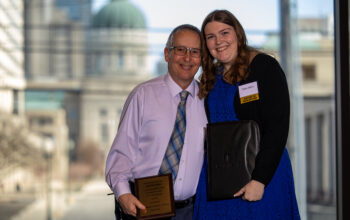A patient who received a first-in-the-world tricuspid valve procedure as part of a new national clinical trial at Franciscan Health Heart Center is home and recovering well.
The procedure utilizes a revolutionary material called extracellular matrix. The material provides a seamless valve structure, which engages and harnesses the heart’s remarkable, inherent ability to heal.
Chief of cardiovascular and thoracic surgery and co-director of the Heart Valve Center, Marc Gerdisch, MD, led the surgical team that successfully implanted the CorMatrix® Cor™ TRICUSPID ECM® Valve device to treat a male patient suffering from endocarditis, an infection of the inner lining of the heart chambers and heart valves. The device, shaped like the native tricuspid valve, enables the patient’s cells to infiltrate the structure and remodel over time, resulting in a fully functioning valve.
During the months following surgery, the extracellular matrix valve becomes the patient’s newly grown tissue. In addition, patients with this valve do not require long-term anticoagulation therapy, such as the blood-thinning agent warfarin, as is required with mechanical valves.
“This first FDA study enrollment is a substantial step toward patients avoiding synthetic or animal tissue replacement valves, by having the opportunity to regrow their own tissue,” said Dr. Gerdisch, the national principal investigator for the adult component of the trial. Franciscan Health Indianapolis is one of eight sites selected nationally for the study.
The past decade has seen an enormous expansion of research in, and subsequently understanding of, extracellular matrix.
“We have been using CorMatrix for eight years with exceptional success in reconstructing complex structures of the heart and blood vessels,” Dr. Gerdisch added. “Given the remarkable adaptability and regenerative properties of CorMatrix, this new valve structure will have a dramatic effect on surgery for tricuspid valve pathology, especially for younger patients. Furthermore, it serves as a platform for engineering other heart valves.”

The device and surgical approach fills a gap in the treatment of tricuspid valve disease, a condition in which the valve between the two right heart chambers (right ventricle and right atrium) doesn’t function properly, noted Dr. Gerdisch, a partner with Cardiac Surgery Associates.
“This important step for our patients and CorMatrix, to create a valve that will mimic in all respects a normal valve is no easy task, but the technology and our ability to harness the regenerative potential continues to improve,” said Robert G Matheny, MD, chief medical and scientific officer for CorMatrix.
“The Cor™ TRICUSPID ECM® valve is the first seamless ECM® cardiac valve approved by the FDA for an IDE safety and feasibility clinical trial for adult and pediatric patient applications,” said Edgar Rey, CorMatrix president and CEO. “We are very pleased to be working with Dr. Gerdisch and through his leadership, with the team at Franciscan Health Heart Center on this important study. The Cor™ TRICUSPID ECM® valve joins a rapidly developing CorMatrix® pipeline of next generation ECM® products and patient solutions.”
Cor™ TRICUSPID ECM® valve is an investigational device and not commercially available.
This isn’t the first innovation Dr. Gerdisch has pioneered at Franciscan Health. In late summer 2018, he and his team were the first in the world to use the WalterLorenz™ Surgical Assist Arm from Zimmer Biomet that Dr. Gerdisch helped develop. The device is a bionic, electromechanical arm providing secure tissue retraction and surgical site optimization. This simple yet sophisticated technology optimizes site exposure, reduces surgery staff fatigue and improves efficiency in the operating room.
Another recent innovation involves a procedure based on the HAART Aortic Annuloplasty. The operation uses a fabric-covered frame — about the diameter of an index finger — that strengthens the internal structure of the aortic heart valve and allows repair of valves that might otherwise be replaced.
To learn more about Dr. Gerdisch’s work at Franciscan Health Heart Center, visit franciscanhealth.org/valvefirst.


